Showing Spotlights 2385 - 2392 of 2838 in category All (newest first):
 Given past revelations of previously top secret military technology programs there is a good chance that some 'black' projects somehwere tinker with advanced nanotechnology applications. But, you keepers of military secrets, relax. This Spotlight is not a piece of investigative journalism into the world of military black projects. It is the first in a series of eight scenarios that have just been published by the Center for Responsible Nanotechnology (CRN) - and we here at Nanowerk have posted the entire nanotechnology scenario project here. CRN's scenarios depict various versions of a near-future world into which transformative manufacturing concepts may emerge. Across eight separate storylines, an international team of policy, technology, and economic specialists organized by CRN imagined in detail a range of plausible, challenging events - from pandemics to climate crises to international conflicts - to see how they might affect the development of advanced nanotechnology over the next 15 years. Please keep in mind that this and the others seven scenarios are NOT predictions but fiction. CRN intends the scenarios to provide a springboard for discussion of molecular manufacturing policies and societal responses. While each scenario can be understood individually, the real value of the process comes from the comparison of multiple scenarios. A strategic response that appears robust in one scenario may be dangerous in another; an organization, community, or polity using these scenarios to consider how to handle the emergence of molecular manufacturing should strive for responses that are viable across multiple scenarios.
Given past revelations of previously top secret military technology programs there is a good chance that some 'black' projects somehwere tinker with advanced nanotechnology applications. But, you keepers of military secrets, relax. This Spotlight is not a piece of investigative journalism into the world of military black projects. It is the first in a series of eight scenarios that have just been published by the Center for Responsible Nanotechnology (CRN) - and we here at Nanowerk have posted the entire nanotechnology scenario project here. CRN's scenarios depict various versions of a near-future world into which transformative manufacturing concepts may emerge. Across eight separate storylines, an international team of policy, technology, and economic specialists organized by CRN imagined in detail a range of plausible, challenging events - from pandemics to climate crises to international conflicts - to see how they might affect the development of advanced nanotechnology over the next 15 years. Please keep in mind that this and the others seven scenarios are NOT predictions but fiction. CRN intends the scenarios to provide a springboard for discussion of molecular manufacturing policies and societal responses. While each scenario can be understood individually, the real value of the process comes from the comparison of multiple scenarios. A strategic response that appears robust in one scenario may be dangerous in another; an organization, community, or polity using these scenarios to consider how to handle the emergence of molecular manufacturing should strive for responses that are viable across multiple scenarios.
Dec 12th, 2007
 Carbon nanotubes (CNTs) have shown promise as an important new class of multifunctional building blocks and innovative tools in a large variety of nanotechnology applications, ranging from nanocomposite materials through nanoelectronics to biomedical devices (e.g. gene and drug carriers). The recent rapid development in nanotechnology has renewed the pressing demand for large-scale production of CNTs for potential applications in commercial products. The number of industrial-scale facilities for the increasingly low-cost production of multi-walled carbon nanotubes (MWCNTs) continues to grow, and with that the professional and public exposure to MWCNTs is expected to increase significantly in the coming years. Owing to their unusual one-dimensional hollow nanostructure and unique physicochemical properties, CNTs are particularly useful as novel drug delivery tools and imaging agents. However, such biomedical, and many other related, applications will not be realized if there is no proper assessment of the potential hazards of CNTs to humans and other biological systems. This situation prompted a group of researchers to carry out the first genotoxicity study of nanomaterials. Although the health effects of nanomaterials have attracted considerable attention, the scientific community has thus far focused primarily on the studies of nanomaterials toxicity at the cellular level. Very little is known about the toxicity at the molecular level, or genotoxicity, of nanomaterials in mammalian cells. Researchers at the University of Dayton have assessed the DNA damage response to MWCNTs in mouse embryonic stem cells (ES). This new work emphasizes the importance of careful scrutiny of the genotoxicity of nanomaterials.
Carbon nanotubes (CNTs) have shown promise as an important new class of multifunctional building blocks and innovative tools in a large variety of nanotechnology applications, ranging from nanocomposite materials through nanoelectronics to biomedical devices (e.g. gene and drug carriers). The recent rapid development in nanotechnology has renewed the pressing demand for large-scale production of CNTs for potential applications in commercial products. The number of industrial-scale facilities for the increasingly low-cost production of multi-walled carbon nanotubes (MWCNTs) continues to grow, and with that the professional and public exposure to MWCNTs is expected to increase significantly in the coming years. Owing to their unusual one-dimensional hollow nanostructure and unique physicochemical properties, CNTs are particularly useful as novel drug delivery tools and imaging agents. However, such biomedical, and many other related, applications will not be realized if there is no proper assessment of the potential hazards of CNTs to humans and other biological systems. This situation prompted a group of researchers to carry out the first genotoxicity study of nanomaterials. Although the health effects of nanomaterials have attracted considerable attention, the scientific community has thus far focused primarily on the studies of nanomaterials toxicity at the cellular level. Very little is known about the toxicity at the molecular level, or genotoxicity, of nanomaterials in mammalian cells. Researchers at the University of Dayton have assessed the DNA damage response to MWCNTs in mouse embryonic stem cells (ES). This new work emphasizes the importance of careful scrutiny of the genotoxicity of nanomaterials.
Dec 11th, 2007
 The Bronze Age technique of soldering - a process in which two or more metal items are joined together by melting and flowing a filler metal into the joint - seems to be working just fine in the nanotechnology age. Researchers in California have developed an alternative method, effectively a miniaturization of soldering, to electron beam lithography (EBL) which, so far, is the method of choice for making electrical contact to nanostructures is. Carbon nanotubes, for instance, have been soldered together by using electron beam deposited gold molecules. There is a downside to using EBL as an industrial fabrication process: commercially used dedicated e-beam writing systems are very expensive (millions of dollars per unit), the process is complex, time-consuming and not really suitable for high-volume manufacturing, and there is a risk of sample contamination build-up on the samples. Other lithography-free contacting techniques such as shadow masks have been attempted, but they have their own drawbacks and have not been widely used. The new nano-soldering technique allows to make submicron sized, Ohmic contacts to nanostructures of even single atom thickness. The technique is simple, inexpensive, rapid, and entirely avoids sample contamination.
The Bronze Age technique of soldering - a process in which two or more metal items are joined together by melting and flowing a filler metal into the joint - seems to be working just fine in the nanotechnology age. Researchers in California have developed an alternative method, effectively a miniaturization of soldering, to electron beam lithography (EBL) which, so far, is the method of choice for making electrical contact to nanostructures is. Carbon nanotubes, for instance, have been soldered together by using electron beam deposited gold molecules. There is a downside to using EBL as an industrial fabrication process: commercially used dedicated e-beam writing systems are very expensive (millions of dollars per unit), the process is complex, time-consuming and not really suitable for high-volume manufacturing, and there is a risk of sample contamination build-up on the samples. Other lithography-free contacting techniques such as shadow masks have been attempted, but they have their own drawbacks and have not been widely used. The new nano-soldering technique allows to make submicron sized, Ohmic contacts to nanostructures of even single atom thickness. The technique is simple, inexpensive, rapid, and entirely avoids sample contamination.
Dec 10th, 2007
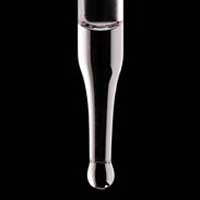 Pipettes (from the French: little pipe) are one of those ubiquitous tools you find in every chemical, medical or biology lab. The original pipette is made of glass and it works by creating a vacuum above the liquid-holding chamber and selectively releasing this vacuum to draw up and dispense liquid. With the advance of molecular biology, researchers required pipettes that were able to confine smaller and smaller amounts of specimen, not only for probing but also for injecting drugs, DNA etc. into cells - without damaging the cells, of course. Just a few months ago, researchers at the Brookhaven National Laboratory have developed what is thought to be the world's smallest pipette: made of a carbon-coated germanium nanowire it can hold a volume of only a few zeptoliters (a billionth of a trillionth of a liter, or one thousand cubic nanometers). Although today it even is possible to process the tip of a glass pipette to have an inner diameter as small as several tens of nanometers, this involves considerable problems in terms of the processing accuracy and the operability of the pipette, particularly in terms of locating the tip. It is generally considered that probes made from carbon nanotubes (CNTs) and nanoscale carbon pipes offer an attractive alternative to glass pipettes because of their small size, high mechanical strength, and high electrical conductivity. Researchers at the University of Pennsylvania have developed a manufacturing technique for carbon nanopipettes (CNPs) that does not require cumbersome nanoassembly and is amenable to mass production.
Pipettes (from the French: little pipe) are one of those ubiquitous tools you find in every chemical, medical or biology lab. The original pipette is made of glass and it works by creating a vacuum above the liquid-holding chamber and selectively releasing this vacuum to draw up and dispense liquid. With the advance of molecular biology, researchers required pipettes that were able to confine smaller and smaller amounts of specimen, not only for probing but also for injecting drugs, DNA etc. into cells - without damaging the cells, of course. Just a few months ago, researchers at the Brookhaven National Laboratory have developed what is thought to be the world's smallest pipette: made of a carbon-coated germanium nanowire it can hold a volume of only a few zeptoliters (a billionth of a trillionth of a liter, or one thousand cubic nanometers). Although today it even is possible to process the tip of a glass pipette to have an inner diameter as small as several tens of nanometers, this involves considerable problems in terms of the processing accuracy and the operability of the pipette, particularly in terms of locating the tip. It is generally considered that probes made from carbon nanotubes (CNTs) and nanoscale carbon pipes offer an attractive alternative to glass pipettes because of their small size, high mechanical strength, and high electrical conductivity. Researchers at the University of Pennsylvania have developed a manufacturing technique for carbon nanopipettes (CNPs) that does not require cumbersome nanoassembly and is amenable to mass production.
Dec 7th, 2007
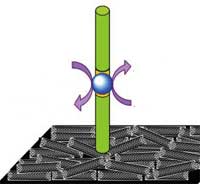 Molecular bioelectronics is a rapidly progressing research field that is concerned with the movement of electrons and ions within living systems. This field brings together the strengths of biological reactions and biochemical interactions from nature with electronic signal detection and amplification of human electronics technology. The result will be new applications in medicine, diagnostics and therapeutics that would never be imaginable within the limitations of each separated domain. One day, bioelectronic devices could even be be directly involved in electrical communication with signal producing or controlling molecules, organelles or structures within our bodies. A more short-term goal, though, is the development of biosensors (such as enzyme-based sensors and DNA sensors) to combine the extraordinary specificity of biochemical receptors with general purpose microelectronics to develop selective probes for diagnostics, drug screening, and toxin detection. An example of recent advances in the field is the work of researchers in the U.S. who have designed an integrated nanobioelectronic system, exploiting the distinct properties of nanowires and carbon-nanotubes, for triggering reversibly and on-demand bioelectrocatalytic transformations of alcohols. Such an adaptive magneto-switchable nanobioelectronic system exploits the distinct properties of its individual nanomaterial components, can be extended to a wide range of biocatalytic systems, and offers great promise for regulating the operation of biofuel cells, bioreactors, and biosensing devices in response to specific needs.
Molecular bioelectronics is a rapidly progressing research field that is concerned with the movement of electrons and ions within living systems. This field brings together the strengths of biological reactions and biochemical interactions from nature with electronic signal detection and amplification of human electronics technology. The result will be new applications in medicine, diagnostics and therapeutics that would never be imaginable within the limitations of each separated domain. One day, bioelectronic devices could even be be directly involved in electrical communication with signal producing or controlling molecules, organelles or structures within our bodies. A more short-term goal, though, is the development of biosensors (such as enzyme-based sensors and DNA sensors) to combine the extraordinary specificity of biochemical receptors with general purpose microelectronics to develop selective probes for diagnostics, drug screening, and toxin detection. An example of recent advances in the field is the work of researchers in the U.S. who have designed an integrated nanobioelectronic system, exploiting the distinct properties of nanowires and carbon-nanotubes, for triggering reversibly and on-demand bioelectrocatalytic transformations of alcohols. Such an adaptive magneto-switchable nanobioelectronic system exploits the distinct properties of its individual nanomaterial components, can be extended to a wide range of biocatalytic systems, and offers great promise for regulating the operation of biofuel cells, bioreactors, and biosensing devices in response to specific needs.
Dec 6th, 2007
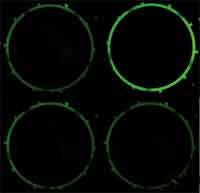 The human body so far is the ultimate 'wet computer' - a highly efficient, biomolecule-based information processor that relies on chemical, optical and electrical signals to operate. Researchers are trying various routes to mimic some of the body's approaches to computing. Especially research related to molecular logic gates is a fast growing and very active area. Already, common logic gates, which are used in conventional silicon circuitry, can be also mimicked at the molecular level. Chemists have reported that a molecular logic gate has the potential for calculation on the nanometer scale, which is unparalleled in silicon-based devices. The general character of the concept of binary logic allows the substitution of electrical signals by chemical and optical signals, which for example opens access to a vast pool of photoactive molecules to be used for the purpose of molecular logic. Molecular logic gate structures using fluorescence changes have been studied intensively using various inputs, such as pH, metal ions, and anions. Now, South Korean scientists using solutions of fluorescent sensor molecules - and, for the first time, proteins - have developed the first soluble molecular logic gates. By using a microfluidic device, input solutions are routed into a central loop, which is filled with a fluorescent sensor solution. There the solutions mix and, in certain combinations, switch the fluorescence 'output' on or off.
The human body so far is the ultimate 'wet computer' - a highly efficient, biomolecule-based information processor that relies on chemical, optical and electrical signals to operate. Researchers are trying various routes to mimic some of the body's approaches to computing. Especially research related to molecular logic gates is a fast growing and very active area. Already, common logic gates, which are used in conventional silicon circuitry, can be also mimicked at the molecular level. Chemists have reported that a molecular logic gate has the potential for calculation on the nanometer scale, which is unparalleled in silicon-based devices. The general character of the concept of binary logic allows the substitution of electrical signals by chemical and optical signals, which for example opens access to a vast pool of photoactive molecules to be used for the purpose of molecular logic. Molecular logic gate structures using fluorescence changes have been studied intensively using various inputs, such as pH, metal ions, and anions. Now, South Korean scientists using solutions of fluorescent sensor molecules - and, for the first time, proteins - have developed the first soluble molecular logic gates. By using a microfluidic device, input solutions are routed into a central loop, which is filled with a fluorescent sensor solution. There the solutions mix and, in certain combinations, switch the fluorescence 'output' on or off.
Dec 5th, 2007
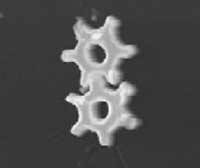 Machines usually require various components such as bearings, gears, couplings or pistons. As machines shrink to the micro- and ultimately nanoscale, their components of course need to shrink with them. One of the major obstacles to the realization of intricate nanomachines like nanorobots is the lack of effective processes for building freestanding nanocomponents with specific shapes and sizes. Self-assembly methods produce both organic and inorganic nano-objects with high yields through 'bottom-up' approaches. The shapes, however, in most cases are confined to rather simple forms such as spheres, rods, triangles and cubes etc. and are not suitable for the elementary components of intricate nanomachines. Meanwhile, the 'top-down' approaches including electron beam lithography and micro-contact printing etc. focus on surface patterning or fabrication of suspended objects, although they can fabricate sophisticated nanostructures. So far, the fabrication and assembly of nano-objects with specific shapes and sizes that can act as elementary components for movable nanoelectromechanical systems (NEMS) is only at the conceptual stage. New research results coming from South Korea now offer the first step toward the realization of sophisticated nanomachines, designed to perform specific tasks, with overall dimensions comparable to those of biological cells.
Machines usually require various components such as bearings, gears, couplings or pistons. As machines shrink to the micro- and ultimately nanoscale, their components of course need to shrink with them. One of the major obstacles to the realization of intricate nanomachines like nanorobots is the lack of effective processes for building freestanding nanocomponents with specific shapes and sizes. Self-assembly methods produce both organic and inorganic nano-objects with high yields through 'bottom-up' approaches. The shapes, however, in most cases are confined to rather simple forms such as spheres, rods, triangles and cubes etc. and are not suitable for the elementary components of intricate nanomachines. Meanwhile, the 'top-down' approaches including electron beam lithography and micro-contact printing etc. focus on surface patterning or fabrication of suspended objects, although they can fabricate sophisticated nanostructures. So far, the fabrication and assembly of nano-objects with specific shapes and sizes that can act as elementary components for movable nanoelectromechanical systems (NEMS) is only at the conceptual stage. New research results coming from South Korea now offer the first step toward the realization of sophisticated nanomachines, designed to perform specific tasks, with overall dimensions comparable to those of biological cells.
Dec 4th, 2007
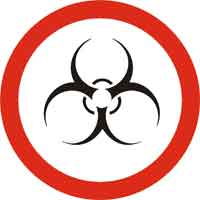 Talking about the threat of terrorists using bioweapons is a great tool for scaring people. Using any kind of pathogen (bacterium, virus or other disease-causing organism) as a weapon certainly is a terrifying scenario; think about the near-panic the 2001 anthrax attacks in the United States caused. Letters containing anthrax spores were mailed to several news media offices and two U.S. Senators, killing five people and infecting 17 others. Can you image what panic would result from an attack that kills 5,000 people and causes 76 million illnesses? Well, as a matter of fact, foodborne diseases cause approximately 76 million illnesses, 325,000 hospitalizations, and 5,000 deaths in the United States each year. Known pathogens account for an estimated 14 million illnesses, 60,000 hospitalizations, and 1,800 deaths. The Food and Drug Administration's 2005 Food Code states that the estimated cost of foodborne illness is $10-$83 billion annually. So while the U.S. spends billions of dollars securing its borders, it loses many more billions, not to mention thousands of lives, every year by not being able to keep its spinach and hamburgers safe. Apparently, talking about terrorism is much better political theater (and makes for catchier Nanowerk Spotlight titles) than discussing E. coli outbreaks. However, be it because of potential terrorists or actual contaminated food, research in microbial detection and decontamination processes increased significantly over the past years. Traditional methods of identifying and subsequently removing a pathogen are slow and cumbersome. Now, using nanotechnology, researchers have designed a novel biosensing system that can identify E. coli in just five minutes and remove up to 88% of the target bacteria.
Talking about the threat of terrorists using bioweapons is a great tool for scaring people. Using any kind of pathogen (bacterium, virus or other disease-causing organism) as a weapon certainly is a terrifying scenario; think about the near-panic the 2001 anthrax attacks in the United States caused. Letters containing anthrax spores were mailed to several news media offices and two U.S. Senators, killing five people and infecting 17 others. Can you image what panic would result from an attack that kills 5,000 people and causes 76 million illnesses? Well, as a matter of fact, foodborne diseases cause approximately 76 million illnesses, 325,000 hospitalizations, and 5,000 deaths in the United States each year. Known pathogens account for an estimated 14 million illnesses, 60,000 hospitalizations, and 1,800 deaths. The Food and Drug Administration's 2005 Food Code states that the estimated cost of foodborne illness is $10-$83 billion annually. So while the U.S. spends billions of dollars securing its borders, it loses many more billions, not to mention thousands of lives, every year by not being able to keep its spinach and hamburgers safe. Apparently, talking about terrorism is much better political theater (and makes for catchier Nanowerk Spotlight titles) than discussing E. coli outbreaks. However, be it because of potential terrorists or actual contaminated food, research in microbial detection and decontamination processes increased significantly over the past years. Traditional methods of identifying and subsequently removing a pathogen are slow and cumbersome. Now, using nanotechnology, researchers have designed a novel biosensing system that can identify E. coli in just five minutes and remove up to 88% of the target bacteria.
Dec 3rd, 2007
 Given past revelations of previously top secret military technology programs there is a good chance that some 'black' projects somehwere tinker with advanced nanotechnology applications. But, you keepers of military secrets, relax. This Spotlight is not a piece of investigative journalism into the world of military black projects. It is the first in a series of eight scenarios that have just been published by the Center for Responsible Nanotechnology (CRN) - and we here at Nanowerk have posted the entire nanotechnology scenario project here. CRN's scenarios depict various versions of a near-future world into which transformative manufacturing concepts may emerge. Across eight separate storylines, an international team of policy, technology, and economic specialists organized by CRN imagined in detail a range of plausible, challenging events - from pandemics to climate crises to international conflicts - to see how they might affect the development of advanced nanotechnology over the next 15 years. Please keep in mind that this and the others seven scenarios are NOT predictions but fiction. CRN intends the scenarios to provide a springboard for discussion of molecular manufacturing policies and societal responses. While each scenario can be understood individually, the real value of the process comes from the comparison of multiple scenarios. A strategic response that appears robust in one scenario may be dangerous in another; an organization, community, or polity using these scenarios to consider how to handle the emergence of molecular manufacturing should strive for responses that are viable across multiple scenarios.
Given past revelations of previously top secret military technology programs there is a good chance that some 'black' projects somehwere tinker with advanced nanotechnology applications. But, you keepers of military secrets, relax. This Spotlight is not a piece of investigative journalism into the world of military black projects. It is the first in a series of eight scenarios that have just been published by the Center for Responsible Nanotechnology (CRN) - and we here at Nanowerk have posted the entire nanotechnology scenario project here. CRN's scenarios depict various versions of a near-future world into which transformative manufacturing concepts may emerge. Across eight separate storylines, an international team of policy, technology, and economic specialists organized by CRN imagined in detail a range of plausible, challenging events - from pandemics to climate crises to international conflicts - to see how they might affect the development of advanced nanotechnology over the next 15 years. Please keep in mind that this and the others seven scenarios are NOT predictions but fiction. CRN intends the scenarios to provide a springboard for discussion of molecular manufacturing policies and societal responses. While each scenario can be understood individually, the real value of the process comes from the comparison of multiple scenarios. A strategic response that appears robust in one scenario may be dangerous in another; an organization, community, or polity using these scenarios to consider how to handle the emergence of molecular manufacturing should strive for responses that are viable across multiple scenarios.
 Subscribe to our Nanotechnology Spotlight feed
Subscribe to our Nanotechnology Spotlight feed





